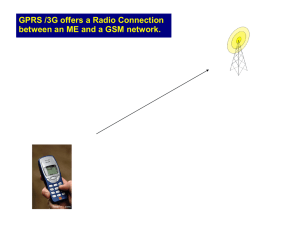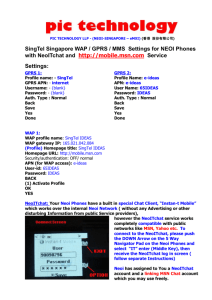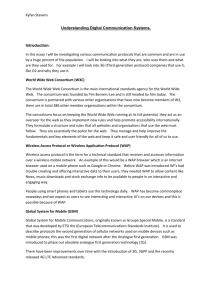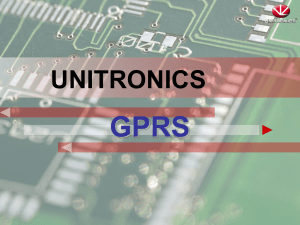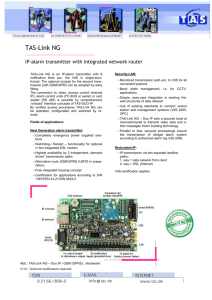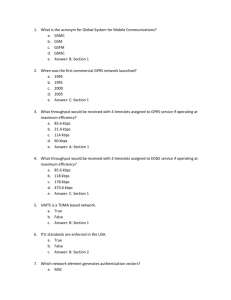TECHNICAL BRIEFING: MOBILE ACCESS TO THE INTERNET
advertisement
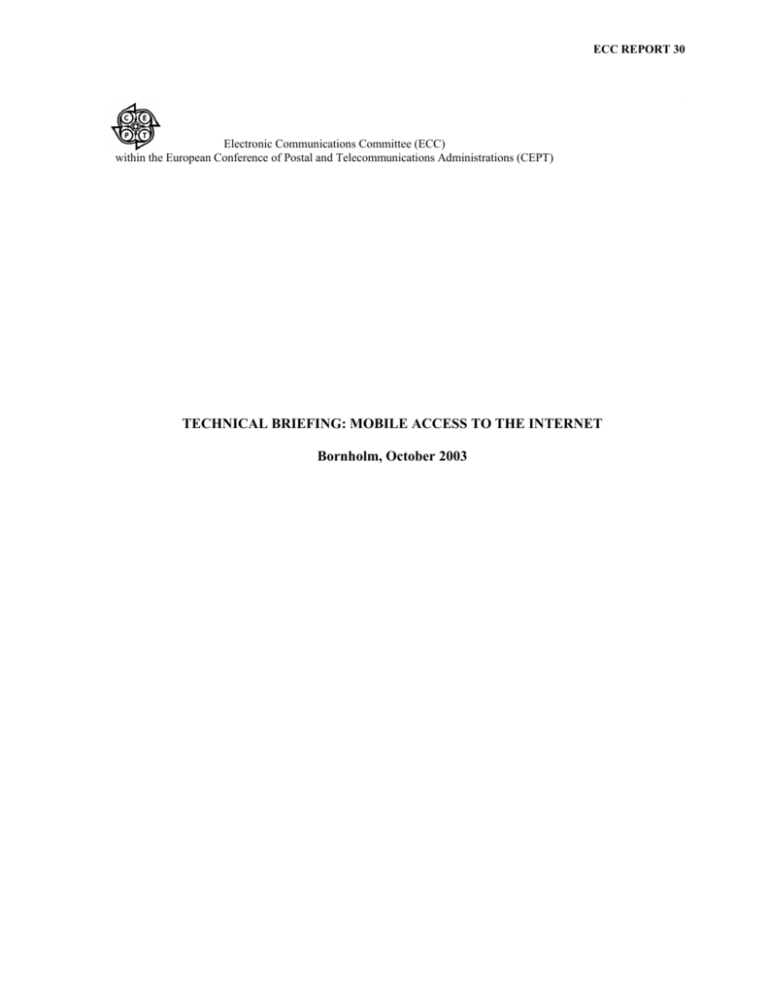
ECC REPORT 30 Electronic Communications Committee (ECC) within the European Conference of Postal and Telecommunications Administrations (CEPT) TECHNICAL BRIEFING: MOBILE ACCESS TO THE INTERNET Bornholm, October 2003 ECC REPORT 30 Page 2 EXECUTIVE SUMMARY The purpose of this report is to provide information on how Internet access is provided by dial-up, GPRS and the initial phases of 3GPP but excluding the IP Multimedia developments. The report covers: • • • • • • • The access configurations The backbone arrangements and interconnections between operators Connections to information sources provided by mobile operators and sources on the public Internet The numbering, naming and addressing arrangements Billing and interconnection payments Location information Privacy The scope for discrimination in access is explored with the conclusion that the main issue is the provision of “open” access to the Gi interface. Provided this issue is handled satisfactorily, there are unlikely to be problems with the allocation of access point names. The basic arrangements described in the standards and GSM MOU documents are satisfactory but there is a possibility of discrimination over access to the Gi interface. Regulators will wish to ensure that access to the Gi interface is available on an open and non-discriminatory basis so that there can be full competition in the provision of Internet access. Implementation is at an early stage and it is too early to draw conclusions whether all operators will offer open non-discriminatory access without intervention by the regulators. It is recommended that these issues are kept under close review for the next two years and that if necessary a requirement is introduced to publish the terms for access at the Gi interface. ECC REPORT 30 Page 3 INDEX TABLE 1 INTRODUCTION ............................................................................................................................................................. 4 2 DIAL-UP ACCESS............................................................................................................................................................ 5 3 ACCESS FROM GPRS .................................................................................................................................................... 6 4 THE GPRS BACKBONE ................................................................................................................................................. 8 5 THE ACCESS POINT NAME AND ITS RESOLUTION ........................................................................................... 9 6 BILLING AND INTERCONNECTION PAYMENTS...............................................................................................11 7 LOCATION INFORMATION ......................................................................................................................................11 8 PRIVACY CONSIDERATIONS ...................................................................................................................................11 9 CURRENT STATUS.......................................................................................................................................................11 10 ANALYSIS .......................................................................................................................................................................12 ANNEX 1: ACRONYMS.........................................................................................................................................................13 ECC REPORT 30 Page 4 1 INTRODUCTION The purpose of this report is to provide information on how Internet access is provided by dial-up, GPRS and the initial phases of 3GPP but excluding the IP Multimedia developments. The scope is shown in figure 1 by the darkened boxes in relation to the standards work for the core networks. The figure shows the three main aspects of the development of mobile networks and the transition from second generation (GSM) via GPRS to third generation. The three aspects concern: • • • The introduction of the new UTRAN air interface and access network based on narrowband and wideband CDMA in different frequency bands. The addition of an IP backbone network for GPRS and early third generation packet data services The creation of new data services initially over tunnels to servers and subsequently new multimedia services. IP Multimedia Tunnels to servers and ISPs Services Circuit switched All IP network Servers replace circuit switches IP Backbone for GPRS Core network Air interface Circuit switched network GSM TDMA/FDM GSM UTRAN CDMA GPRS/GSM Release 3 then 4 Release 5 Figure 1: Scope of report This report relates to standards up to the end of Release 4. There are two access systems, dial-up and GPRS, and they use some common facilities. Dial-up is described first and then the GPRS arrangements are added because this reflects the sequence of the developments. 3GPP (excluding the IP Multimedia) will use the same system as GPRS but with a different air interface. Two classes of Internet protocol are used over access provided by mobile networks: • • Wireless Access Protocol – WAP- (a protocol designed for the display of information on small screens such as are found on mobiles) Normal Internet protocols (eg HTTP, SMTP, FTP etc) eg when the user has a laptop with a larger screen. WAP servers may be connected to the public Internet but are accessed via intermediate WAP gateways because the WAP protocol is not fully Internet compatible. The descriptions in this report are “typical” for an advanced operator, but there may be differences in the details from one operator to another. ECC REPORT 30 Page 5 In general the approach to data services and information has moved from earlier ideas of providing services exclusively for one’s own customers (restricted connectivity) to following the Internet model where every user has the possibility of access to all services (global connectivity). 2 DIAL-UP ACCESS Mobile users can access the Internet by dial-up. A circuit switched call can be established to any network access server by dialling the E.164 number for the server. Users may reach 3rd party ISPs in this way and pay the mobile operator for the dial-up connection only. The following describes Internet access via the user’s home mobile network and is illustrated in figure 2 (NB: Some operators use public IP addresses where the diagram shows private IP addresses.) Network Access Server 3rd party E.164 Network Access Server Mobile’s Home Network E.164 Identified by URL Home operator NAS selected by E.164 number MSC visited RADIUS protocol Client GMSC WAP server 3rd party Server Collects CLI and cell ID Private IP network (private addresses) Network Access Server GMSC Circuit switched GSM networks WAP Gateway Private IP network Use URL for routing CLI and location can be passed E.164 BSC WAP server Gi interface Internet Gateway WAP server (NAT) 3rd party GPRS access Private IP address (stored in mobile) Public Internet WAP server 3rd party web hosts Identified by URL Figure 2: GSM circuit switched access connection The user dials the E.164 number of the Network Access Server (NAS) of their home mobile operator. This E.164 number may be stored in the mobile phone and dialled “invisibly” to the user. The NAS is connected via the home operator’s private IP network to a WAP gateway and an Internet gateway. The RADIUS protocol operates between the NAS and the gateway. The gateway can access the customer records to check that the caller’s CLI is authorised for WAP/Internet access. The caller’s Cell ID will also be passed to the gateway. The gateway to be used will be identified by its private IP address that is loaded into the terminal when the access is first set-up. The gateway allocates a private IP address dynamically to the mobile terminal. The user can then access one or more WAP servers or any other type of host using either WAP or Internet protocols. The home operator’s own WAP and other servers will be connected to the gateways via another private IP network. This network may also be used to support 3rd party servers and hosts. The gateways also connect to the public Internet and users may access 3rd party WAP servers and hosts on the public Internet. They may also access WAP servers and hosts that belong to other mobile operators via the public Internet. The selection of the server/host is made by its URL. Even servers and hosts that are accessed only via the home operators private IP network will have a publicly registered URL to ensure uniqueness. The gateways interact with the messages at the application level and provide URL resolution for the URLs served on the private IP network. ECC REPORT 30 Page 6 The Internet gateway in most cases provides an Network Address Translator function that maps the mobile terminal’s private IP address and port number combination to a public IP address and port number as many mobile operators need to re-use and share scarce public IPv4 addresses. 3 ACCESS FROM GPRS GPRS access is the equivalent of the dial-up connection and NAS, and it provides “always-on” access into the same private IP network that the NAS, WAP and Internet gateways are connected to. GPRS networks have a structure similar to the GSM network: • • the Serving GPRS Support Node (SGSN) is equivalent to the MSC and connects to the radio base station controller that handles the radio base stations in an area. the Gateway GPRS Support Node (GGSN) is equivalent to the GMSC and provides the connection point to other networks The GPRS nodes of each operator are interconnected on a private IP network. The access connection (the technical name is PDP Context) can be thought of as a “flexible tunnel” through the GPRS networks that is established by the GPRS Tunnelling Protocol (GTP). The arrangement is shown in Figure 3. The GTP tunnel extends from the SGSN to the GGSN. A mobile may support several PDP Contexts simultaneously. User request Access Point Name identifies GGSN exit Visited SGSN Base stations not shown GTP Tunnel GGSN Distinguished by APN Home or visited GPRS backbone Mobile “Mobile” end which can Transfer to another SGSN as the mobile moves Fixed end Gi interface Figure 3: The GPRS access connection The interface on the far side of the GGSN is called the Gi interface. A GPRS user can access the following types of access point: • • • a Virtual Private Network connected to their home mobile operator (APN = <name of VPN>.mnc.mcc.gprs) a third party ISP connected to their home mobile operator (APN = <name of ISP>.mnc.mcc.gprs) the Internet using either normal Internet protocols or WAP via the visited network’s connection to the Internet (APN = “Internet”). The APN is resolved into an IP address for the access point and the tunnel to the access point is opened. The mobile terminal is then assigned an IP address by an entity on the far side of the Gi interface. For Internet access via the mobile network the IP address is assigned by the WAP gateway or Internet gateway. This address may be public or private and may be assigned permanently or temporarily. This IP address is not seen by other nodes in the GPRS backbone network as it passes unexamined through the GTP tunnel. It should be emphasised that the APN identifies the form of access and that one APN value (“Internet”) is used for all local Internet and WAP access. The APN is not the URL of an information source that the user wishes to interrogate. A user may access many different information sources with a GPRS access established with a single APN. For the tunnel between the SGSN and the GGSN, i.e. the section across the GPRS backbone, there is a tunnel identifier (TID) distinguishing each user’s tunnel. The tunnel ID relates to the GTP protocol running between the SGSN and the GGSN, and there are IP addresses for the source and destination SGSN/GGSN interfaces at each end of the tunnel. ECC REPORT 30 Page 7 Figure 4 shows in simplified form communications in progress between a mobile and an entity in the public Internet. The gateway may or may not include a Network Address Translator (NAT). If a NAT is used then the mobile is assigned a private IP address and this address is converted into a public IP address that is used on the public side of the NAT. If a NAT is not used, then the mobile is assigned a public IP address. GPRS domain APN (points to Home Gateway, VPN or 3rd party ISP) Allocation of IP address A NAT if present GTP Tunnel A SGSN visited Inter-PLMN backbone B GGSN Home gateway VPN or 3rd party ISP home IP address A (public unless a NAT is used) Internet Public IP address B End-to-end communication path IP address F within backbone IP address G within backbone Figure 4: Communications between a mobile and the public Internet The Figure 5 gives further information on the assignment of IP addresses to the mobile terminal for different types of access point. Access Point Type “Internet” VPN WAP only Internet access Internet access compatible with NAPT Open Internet access Tunnel goes via GGSN of visited network Any GGSN to which VPN is connected Any GGSN that serves the WAP gateway indicated by the APN Any GGSN that serves the Internet gateway indicated by the APN Any GGSN that serves the Internet gateway indicated by the APN IP address allocated by Visited network operator IP address type Public or private Address assignment Dynamic Operator of VPN Private Static or dynamic Operator of WAP gateway Private Dynamic Operator of Internet gateway (ie home network or third party) Operator of Internet gateway (ie home network or third party) Private Dynamic Public Static or dynamic Figure 5: IP address assignment for different forms of access point Although static address assignment is allowed in some of the documentation, its use is not recommended because it uses too many addresses and causes problems when roaming mobiles try to access local APNs. Figure 6 shows the whole scheme with both GPRS and dial-up access. The diagram applies for a mobile on its home network, ie not roaming. ECC REPORT 30 Page 8 Network Access Server Network Access Server 3rd party E.164 Mobile’s Home Network E.164 Identified by URL Home operator NAS selected by E.164 number Client GMSC MSC visited RADIUS protocol WAP server WAP server Server Collects CLI and cell ID Network Access Server GMSC Circuit switched GSM networks Private IP network (private addresses) WAP Gateway Private IP network Use URL for routing CLI and location can be passed Internet Gateway WAP server (NAT) E.164 BSC 3rd party 3rd party Private IP address (stored in mobile) GPRS access Public Internet WAP server Internet and WAP access Gi interface APN = Internet Identified by URL GTP tunnel SGSN 3rd party web hosts GGSN VPNs with different APNs GPRS backbone 3rd party ISPs with different APNs Figure 6: GPRS (non-roaming) and dial-up access to the home network 4 THE GPRS BACKBONE The figure above shows the home operator’s own GPRS backbone. In practice, each operator or group of related operators has their own backbone and these backbones are being interconnected by GPRS Roaming eXchanges (GRX) to form an international transit backbone. The first GRX was established in Amsterdam and others are expected to open soon (eg Hong Kong). Connections to the GRX or direct connections between operators may use leased lines or IPSec tunnels over the Internet. The backbones of individual operators use private IPv4 addresses, but the international backbone uses publicly registered IPv4 addresses even though it is a closed network and not interconnected to the Internet. The use of public addresses is a precaution in case it is interconnected with the Internet in the future and also makes use of the allocation arrangements that ensure the uniqueness of public IP addresses. ECC REPORT 30 Page 9 Figure 7 shows the GPRS backbone arrangements. SGSN SGSN SGSN Internal DNS Internal DNS Private backbone SGSN GGSN Private backbone GGSN External DNS External DNS Publicly registered IP addresses Operator A GRX External DNS SGSN Operator B Leased lines or IPSEC tunnel on the Internet GRX International backbone External DNS SGSN SGSN Internal DNS Internal DNS Private backbone SGSN SGSN Private IP addresses Private IP addresses SGSN SGSN GGSN Private backbone GGSN Private IP addresses SGSN SGSN Private IP addresses SGSN SGSN Operator C SGSN Operator D Figure 7: GPRS backbone arrangements The international backbone is used for the following communications: • • 5 DNS resolutions when a roaming mobile wishes to access an APN on its home network GTP tunnels from a visited SGSN in a roaming network to the GGSN in its home network that servers the APN THE ACCESS POINT NAME AND ITS RESOLUTION The Access Point Name (APN) identifies an access point on the far side of a GGSN. The APN is composed of two parts as follows: • The APN Network Identifier which defines the external network or service that the user wishes to connect to via the GGSN. • The APN Operator Identifier which defines in which mobile network the GGSN is located. The APN Operator Identifier is placed after the APN Network Identifier. An APN consisting of both the Network Identifier and Operator Identifier has the form of a domain name for an access point. The format of the APN is shown in figure 8. <Network ID> . <MNC>.<MCC>.gprs Network ID Operator ID Figure 8: APN structure Where MNC is the Mobile Network Code and MCC is the Mobile Country Code. ECC REPORT 30 Page 10 In order to guarantee the uniqueness of the APN Network Identifier within the GPRS PLMN(s), an APN Network Identifier corresponds is registered as an Internet domain name. When a GPRS terminal logs on to its home or a visited network, it selects which access point it wishes to access by specifying the Access Point Name (APN). The following example explains how a tunnel is established to access point indicated by the APN selected by the terminal: 1. The user identifies the requested access point by the network ID part of the APN (eg xyz.com) and the terminal sends this information to the SGSN. 2. The SGSN adds the operator ID of the visited network to give “xyz.com.mnc00A.mcc00X.gprs” where the operator ID (home or visited) is mnc00A.mcc00X. (mnc = mobile network code prefixed with 0 if the code is 2digits; mcc = mobile country code). This string is the whole APN. 3. The network interrogates its own local DNS. If the APN is “Internet” or if the network is the mobile’s home network then the resolution is successful and the IP address of the GGSN that supports the APN is returned. 4. If the mobile is roaming on a visited network, the resolution of that APN fails because xyz.com is not known in the visited network. The visited SGSN then changes the operator ID to the home operator ID and sends the request to its external DNS that holds information on the IP addresses in the international backbone for the external DNSs of all other operators with which the operator has roaming agreements. There is no root DNS for the international backbone. 5. The visited SGSN then queries the external DNS of the home operator to find the IP address of the GGSN that serves the APN. 6. The SGSN establishes a tunnel to the GGSN using the GPRS Tunnelling Protocol (GTP) connecting the roaming terminal and the access point. The sequence of interrogations for a roaming mobile is shown in Figure 9. Internal DNS A APN xyz.com.mnc00A.mcc00X.gprs External DNS A External DNS B Not found APN= xyz.com.mnc00B.mcc00Y.gprs Location of DNS B Location of home GGSN APN xyz.com SGSN Visited operator’s GPRS backbone International backbone Home operator’s GPRS backbone GGSN Base stations not shown Visited operator A mnc00A, mcc00X Visited operator B mnc00B, mcc00Y Figure 9: APN resolution and establishment of a GTP tunnel The GTP tunnel is connection orientated and is held as long as the terminal remains logged on (always-on). APN xyz.com ECC REPORT 30 Page 11 6 BILLING AND INTERCONNECTION PAYMENTS Data for billing the end user is collected by the SGSNs that the user visits. The SGSNs record the volume of incoming and outgoing packets and produce records that are forwarded to the home network operator and used for the user’s bill. The user pays the home network operator. The same data is used by the visited operator to prepare inter-operator bills for roaming mobiles. Both the above follow the established “telco” payment model. Payments for the international GPRS backbone follow the Internet model. Operators pay their own costs for traffic to and from the GRXs and pay on a capacity basis for connections at the GRX. The latter payments cover the costs of running the GRXs and their interconnections. 7 LOCATION INFORMATION Most mobile networks have the capability to provide location information on mobiles and this information will be valuable to many services. Currently information obtained from circuit switched access is more accurate than that obtained from GPRS access but with GPRS access the Cell ID used by the mobile is available. When the mobile accesses a WAP or Internet server, the mobile network gateway is able to send the server the Cell ID of the mobile as well as its CLI. The Cell ID can be processed to give the approximate location of the mobile. Mobiles are not able currently to obtain their own location from the network. 8 PRIVACY CONSIDERATIONS The operators expect that they may have to change some of their arrangements to comply with the requirements of the directive on privacy and electronic communications (2002/58/EC) concerning CLI and location information. Opt-in is required for location information, and for both there has to be a simple means for the user to suppress the presentation of this information, but CLI may have to be passed to external networks as part of the authentication process and there is no way of suppressing this. 9 CURRENT STATUS The development of GPRS is still at a relatively early stage. The current status is as follows: • • • • • All GPRS operators offer their own access to the Internet including access to WAP servers A number of organisations use GPRS for access to their VPNs The connection of 3rd party ISPs to the Gi interface is at a relatively early stage The international GPRS backbone is still being established and it is now no longer clear that a root server for Access Point Names will be implemented because the current distributed system is proving to be satisfactory. Web browsing and most forms of email operate satisfactorily but NAPTs will not operate with services that require the ability for communications across the NAPT to be initiated in an incoming direction. ECC REPORT 30 Page 12 10 ANALYSIS Access to the Internet and support of roaming are still being developed. Not all the forms of access identified by the GSM MOU are implemented yet, even by the leading operators, and the number of networks on which roaming is possible is somewhat limited but growing rapidly. In technical terms, the range of options planned is adequate and non-discriminatory. Users can access the Internet and 3rd party WAP servers connected to the Internet, and any 3rd party information provider can offer services to all GPRS users by connecting to the Internet. If discrimination should arise it is likely to relate to the commercial terms for connection by 3rd party ISPs at the Gi interface including the allocation to them of APNs. However the impression given by operators is that they appreciate the value of other players in increasing the number of GPRS users especially as the initial take-up of GPRS has been disappointing and so will assist the connection of 3rd party ISPs who would introduce their own customers to GPRS. The discrimination could involve overcharging for access to the Gi interface. This access would allow a 3rd party to provide an Internet or WAP gateway, however discrimination would not prevent users having access to services on the Internet (eg email by another provider) via the Internet access offered by their home operator, and therefore it may not be a major issue for most users. In conclusion, the main issue is the provision of “open” access to the Gi interface. Provided this issue is handled satisfactorily, there are unlikely to be problems with the allocation of access point names. The basic arrangements described in the standards and GSM MOU documents are satisfactory but there is a possibility of discrimination over access to the Gi interface. Regulators will wish to ensure that access to the Gi interface is available on an open and nondiscriminatory basis so that there can be full competition in the provision of Internet access. Implementation is at an early stage and it is too early to draw conclusions whether all operators will offer open non-discriminatory access without intervention by the regulators. It is recommended that these issues are kept under close review for the next two years and that if necessary a requirement is introduced to publish the terms for access at the Gi interface. ECC REPORT 30 Page 13 ANNEX 1: ACRONYMS 3GPP APN ccTLD CC CLI DNS ENUM ETSI GGSN GMSC GPRS GSM gTLD GTP HLR ICANN IETF IIN IM IMEI IMSI IP ISP ITU MCC MII MNC MSC MSIN MSISDN MSRN MVNO NAT PLMN SGSN SIM SIP TLD UCI UMTS UTRAN VMSC WAP 3rd Generation Partnership Project Access Point Name country code Top Level Domain Country Code Calling line indication Domain Name System A working group of IETF developing a method for resolving E.164 numbers into names for Internet resources European Telecommunications Standardisation Institute Gateway GPRS Support Node Gateway Mobile Switching Centre GSM Packet Radio System Global System for Mobiles Generic Top Level Domain GPRS Tunnelling Protocol Home Location Register Internet Corporation of Assigned Names and Numbers Internet Engineering Task Force Issuer Identification Number IP Multimedia International Mobile Equipment Identity International Mobile Station Identity Internet Protocol (IPv4: version 4, IPv6: version 6) Internet Service Provider International Telecommunication Union Mobile Country Code Major Industry Identifier Mobile Network Code Mobile Switching Centre Mobile Station Identification Number Mobile Subscriber Integrated Services Digital Network Mobile Station Routing Number Mobile Virtual Network Operator Network Address Translator Public Land Mobile Network Serving GPRS Support Node Subscriber Identity Module Session Initiation Protocol Top Level Domain Universal Communications Identifier Universal Mobile Telecommunications System UMTS Terrestrial Radio Access Network Visited Mobile Switching Centre Wireless Application Protocol
